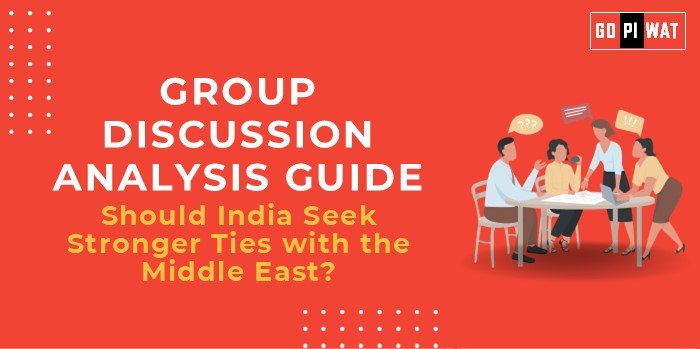📋 Group Discussion Analysis Guide
🌟 Should India Seek Stronger Ties with the Middle East?
🌐 Introduction
The Middle East, particularly the Gulf Cooperation Council (GCC) nations, plays a pivotal role in shaping India’s trade, energy security, and diaspora economics. With the region surpassing the EU as a trading partner, stronger ties are essential for India’s strategic and economic goals.
📊 Quick Facts & Key Statistics
⚡ Energy Security: Over 80% of India’s crude oil imports come from the Middle East, a vital component of the country’s energy landscape.
💵 Remittances: Approximately 8.8 million Indian nationals in the Gulf significantly contribute to India’s foreign exchange reserves.
🌍 Strategic Investments: UAE has committed $75 billion, and Saudi Arabia has plans for $100 billion in investments in India.
👥 Stakeholders and Their Roles
- 🇮🇳 Governments: Facilitate bilateral agreements and economic collaboration.
- 🏗️ Private Sector: Drive trade and infrastructure development partnerships.
- 🌏 Indian Diaspora: Serve as a cultural and economic bridge through remittances and investments.
- ⚖️ International Entities: Mediate geopolitical stability to secure trade and energy routes.
🏆 Achievements and ⚠️ Challenges
✨ Achievements:
- 💹 Trade Leadership: GCC trade surpassing the EU showcases a robust economic partnership.
- ⚡ Energy Security: Reliable crude oil imports ensure economic stability.
- 🤝 Economic Integration: UAE’s $75 billion and Saudi Arabia’s $100 billion investment commitments.
- 💵 Diaspora Contributions: Gulf remittances strengthen India’s foreign exchange reserves.
⚠️ Challenges:
- 🌍 Geopolitical Volatility: Regional conflicts pose risks to trade and energy security.
- 💼 Labor Concerns: Protecting 8.8 million Indian workers in the Gulf remains a challenge.
- 🛢️ Dependency Risks: Over-reliance on Middle Eastern crude oil.
- 🤝 Competition: Managing regional influence from powers like China and the US.
✅ Effective Discussion Approaches
- 📜 Opening Approaches:
- Highlight the GCC surpassing the EU as India’s second-largest trade partner.
- Emphasize the importance of the Gulf’s 8.8 million-strong Indian diaspora in remittances and cultural ties.
- 🛠️ Counter-Argument Handling:
- Address over-dependence on Middle Eastern crude oil by emphasizing India’s renewable energy initiatives.
- Mitigate geopolitical risks by referencing trilateral partnerships (e.g., India-Middle East-Africa corridors).
📈 Strategic Analysis of Strengths & Weaknesses
- 🏅 Strengths:
- Strong trade and investment ties with GCC nations.
- Reliable energy supplies.
- Large Indian diaspora acting as cultural and economic ambassadors.
- ⚠️ Weaknesses:
- High dependency on oil imports.
- Challenges in ensuring labor welfare for Indian workers.
- 💡 Opportunities:
- Renewable energy partnerships.
- Enhanced defense collaboration.
- Expanding trade corridors, like the India-Middle East-Europe corridor.
- ⚡ Threats:
- Geopolitical instability in the Gulf region.
- Rising competition from China’s Belt and Road initiatives.
📜 Structured Arguments for Discussion
Supporting Stance: “Stronger ties with the Middle East bolster trade, energy security, and economic investments, cementing India’s strategic position globally.”
Opposing Stance: “Over-dependence on the Middle East poses risks, particularly in energy security and geopolitical conflicts.”
Balanced Perspective: “Deeper engagement with the Middle East is vital, but India must diversify energy sources and protect its diaspora to mitigate risks.”
🎓 Connecting with B-School Applications
- 📚 Real-World Applications: Explore opportunities for sustainable development through trilateral partnerships and renewable energy initiatives.
- 💬 Sample Interview Questions:
- “How can India balance trade and strategic partnerships with Middle Eastern nations and other global powers?”
- “What are the implications of remittances on India’s economy?”
- 🔑 Insights for B-School Students: Highlight the role of energy, trade, and human resources in shaping international business strategies.


